editor's note
This article is an edited version of the live speech delivered by Professor He Jiaxun, an expert in strategic brand management, at the "Third Occidental 911 Super Brand Day Summit". Professor He Jiaxun put forward the theory of "Entrepreneur Brand Strategy" as a new content to create a strategic brand management system different from that in Europe and America ("Strategic Brand Management-Enterprise and Customer Collaborative Strategy", 2021). This new idea has been transformed into a methodology for executive and entrepreneur courses, which is widely recognized and welcomed by the business community. This year's "Tsinghua Management Review" No. 9 (page 70-75) published the core content of Professor He Jiaxun's theoretical thought on entrepreneurial brand strategy.
In 20 minutes today, I will give you a clear sentence and solve a problem. In a word, it is to move from brand management of managers to brand strategy of entrepreneurs; to solve one problem is that most companies now have marketing activities but lack brand positioning. Without brand positioning, there is no top-level design of brand strategy! I very much agree with OSESS's understanding of brand positioning in practice, which is the core value.
I pointed out a long time ago that we should not stop at the level of positioning theory proposed by Al Ries and Jack Trout in the 1970s. This is a psychological positioning rather than a strategic positioning . So today, if we want to realize the real brand strategy and implement the brand strategy, we must move from manager brand management to entrepreneur brand strategy.
Chinese corporate practice has changed western textbook theory
The nature of the brand is overall and comprehensive, and the soul of the brand permeates every field, every link, every process and every detail of the enterprise. With this understanding, we need to establish an entrepreneurial brand strategy system. Compared with the brand manager system established by Procter & Gamble in the 1930s recorded in Western textbooks, it is quite different from the practice of how our Chinese companies have established brands since China’s reform and opening up more than 40 years ago. The practice of Chinese enterprises has advanced and changed the so-called classic theories established by the West in a mature economic environment.
I made a comparison, because of time constraints, I can't expand them one by one. Procter & Gamble has many brands, and we can see many different product brands under one product line. For example, shampoo is a product line. Below it is the anti-dandruff shampoo "Head & Shoulders", and the shampoo "Pantene" for healthy maintenance. These are the product brands. But the most important task for Chinese enterprises to build brands today is not to follow this model. I believe that the entrepreneur friends present here generally need to make breakthroughs in brand building. The work of corporate branding or company branding is closely related to the process of brand building and entrepreneurship. Entrepreneurship is brand creation, and brand creation is the process of entrepreneurship. Therefore, according to the brand positioning of the product type under the product line, there is no way to solve the real problem of enterprise development and growth, especially the brand strategy problem of entrepreneurial companies.
This is why we have to go beyond the so-called brand manager system from the 1930s. The brand manager system is feasible when a mature large enterprise develops product brands, but just like the establishment of the "Champion Elephant" brand introduced by Osaisi, it directly affects the growth and development of the entire company. If it is not considered at the level of the overall corporate strategy, it will not be conducive to the realization of real corporate growth. So today we must pay attention to entrepreneurial brand strategy. The core of this system is for entrepreneurs to lead and dominate the company's brand strategy, emphasizing the top-level design of brand strategy and integrating brand strategy with the company's development strategy. This is what I want to emphasize that we must solve.
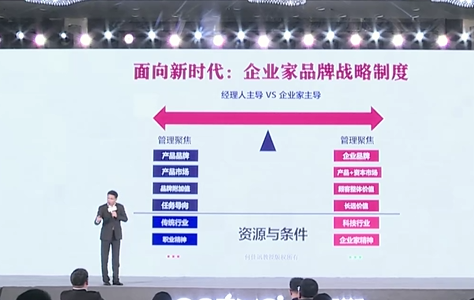
To give a simple example, many big companies seem to have a good reputation and even have a large market share in the world, but they still haven't solved the real brand positioning. For example, Bosideng down jacket has no brand positioning strategy. "Best-selling in 72 countries around the world" and "For you in the cold wind, we have worked hard for 46 years", this is not positioning, because it is not the core value proposition of the brand.

Iris, the founder of positioning theory, passed away some time ago, and Jack Trout passed away a few years ago. We give due respect and admiration to these two founders of the business field in the 1970s, but the theory must Move forward with the practice of today's new era. We should have the courage and confidence to rewrite Western textbooks and create new theories needed for new business practices.
Before I came today, our college talked with Hisense Group about school-enterprise cooperation. Hisense Group has acquired many well-known Western brands. After the acquisition, the management knowledge of Chinese practice can be exported to the acquired company to change their business performance. This is the knowledge based on Chinese practice today can affect the world, not just serve the needs of our local practice in China. I put forward a new theoretical system of strategic brand management. If you think hard about and understand strategic brand management, you should read three textbooks—European textbooks, American textbooks and textbooks written by me. Each of the three textbooks has different theoretical orientations.
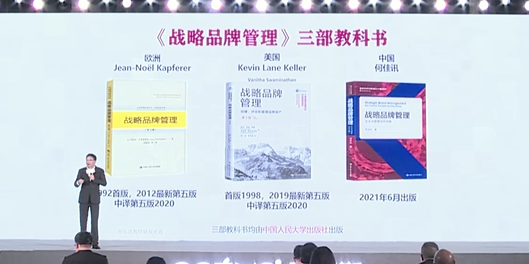
The reason why everyone agrees with the new theoretical system I put forward is because they truly understand the nature of the brand. It is definitely not doing some promotion and marketing activities, which cannot really solve the long-term growth of the brand and the development of the enterprise. Today, Chinese enterprises realize the process of brand creation. Based on this practice, the new theory we establish can affect the world. European textbooks are based on a corporate perspective (brand identity) but do not incorporate a cognitive theory of the customer. The textbooks in the United States are only from the standpoint of the marketing department, how to build a brand by changing the mind of customers. Both of these have limitations.
My textbook "Strategic Brand Management - Enterprise and Customer Collaborative Strategy" was published by Renmin University of China Press last year. Over the past year, I have received feedback from many entrepreneurs, and my theoretical system has a deep resonance. Brand creation must understand the nature of the brand, which is overall and comprehensive, and cannot be solved by one department or one manager, so why should there be an entrepreneurial strategy brand system, where the top leader will lead the brand strategy of the entire company, different functions Departments and managers work together and coordinate to move the brand strategy forward.
Facing the New Era: One Body Two Wings Entrepreneur Brand Strategy System
The theoretical logic of my new theory is the collaborative strategy between enterprises and customers. I have established an enterprise-level brand strategy architecture with two wings, one body includes three layers, and the highest layer is the top-level design of brand strategy, which is actually the interface between enterprises and customers. The top-level design involves all links, and we must combine our brand strategy with company development, industry trends, and strategic positioning; from the perspective of customers, we can recognize and perceive the performance of brand strategy in a 360-degree, all-contact point; The perspective of an enterprise is the external expression of constructing, creating and delivering brand value results. Brand strategy and corporate strategy are intertwined and integrated to promote and develop each other.
The implementation and development of brand strategy requires the cooperation of two systems, with the management system in the middle. I listed four pillars, including strategic management, marketing management, operations management and financial management, each of which produces different values. The bottom layer is called enterprise basic system, including corporate governance, human and organizational capital, information infrastructure, network resources, research and development, and corporate culture. The basic system supports the management system, and the two systems promote each other to support the realization of the brand strategy. In addition, there are two wings, that is, two important tasks that run through all functions and departments of the enterprise. The first is the business model, and the second is system innovation.
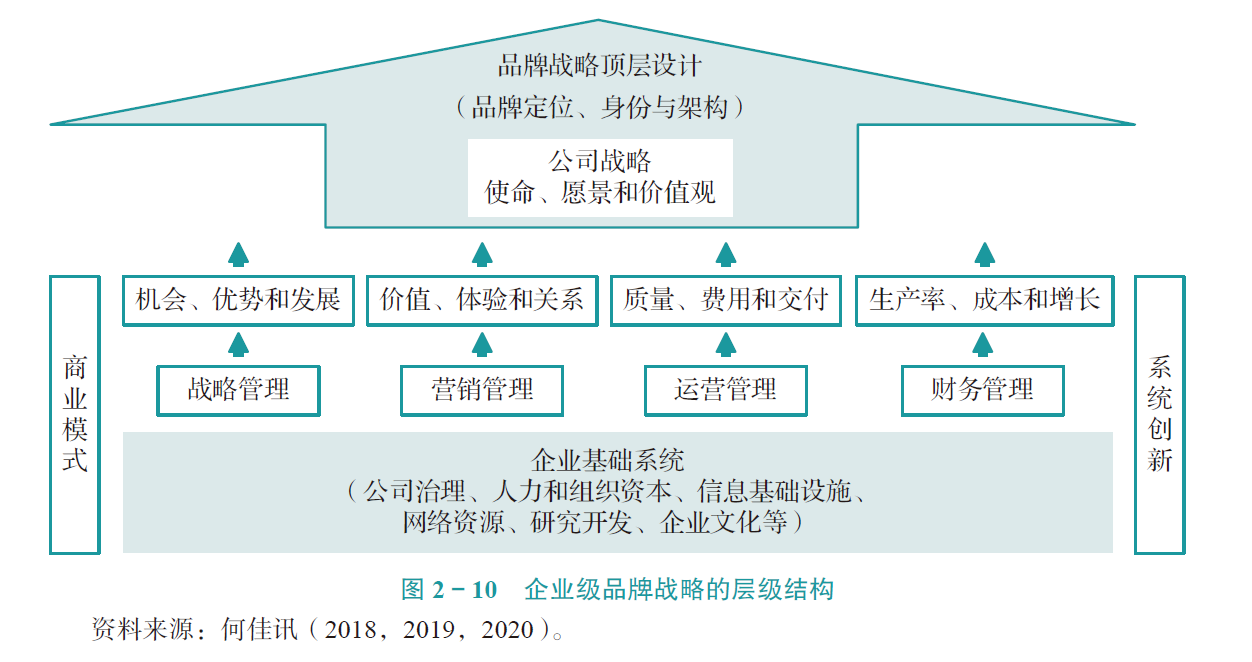
In April this year, experts and I reviewed the brand cultivation project of the Ministry of Industry and Information Technology, and various local provincial and municipal governments vigorously promoted this work. In the declaration and performance evaluation and acceptance of this project, I listened to reports from many companies. There are two types of brand work carried out in practice, one is the functional-level work on the left, which is vividly described in the company's report; the other is the enterprise-level work on the right. The difference is that the work on the left can be done by managers or certain departments, but the work on the right requires the overall operation of the enterprise, and requires entrepreneurs to closely integrate the top-level design of the business and the brand. More and more companies are moving from the left to the right, which means that entrepreneurs have the soil and conditions to practice their brand strategy, and everyone really realizes that the promotion of brand strategy should adopt enterprise-level theoretical logic.
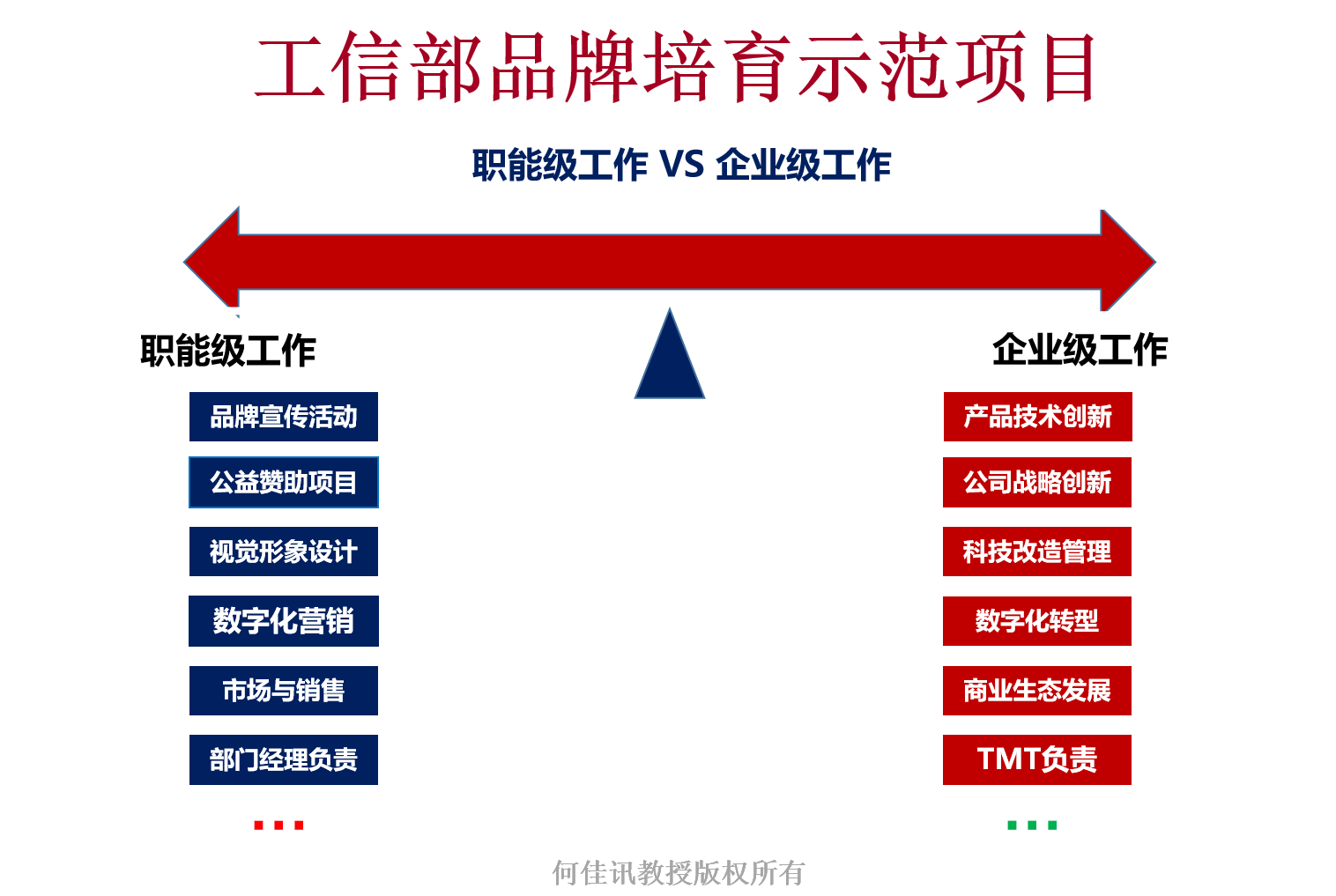
Facing the New Era: The Dual Nature of Brands
The first principle of shifting from functional-level work to enterprise-level work is that we need to understand the nature of the brand. I put forward the theory of dual nature. I will use Lao Tzu's Yin-Yang interaction theory to explain it to you. There are two natures of a brand, the first is a strategy-driven nature, top-down; the second is customer-oriented, bottom-up. In the early days of reform and opening up, we had a lot of growing market dividends. Many of the first generation of entrepreneurs came from the bottom up, seizing market opportunities, starting businesses, and making enterprises bigger. But today is facing a new era of uncertainty, an era in which economic development is driven by technological innovation. We must have a top-down long-term strategy in order to be able to resist the cycle of economic downturn.
The nature of these two natures is different. It is long-term and consistent from top to bottom, and it is based on the company's resources and capabilities; while the customer-oriented nature emphasizes the relevance of the brand to the market and satisfies the diversity of different customer needs. It emphasizes insight and response. The two seem contradictory. But if you understand Lao Tzu's balance theory of yin and yang, you will understand that there is yang in yin, and yin in yang. This is the mystery of Taiji diagram. The essence of Chinese thought is not Cartesian dualism, choose one of the two, but can find harmony and unity in the seemingly contradictory relationship between the two. This is a fundamental understanding of the new theory-brand dual nature theory.
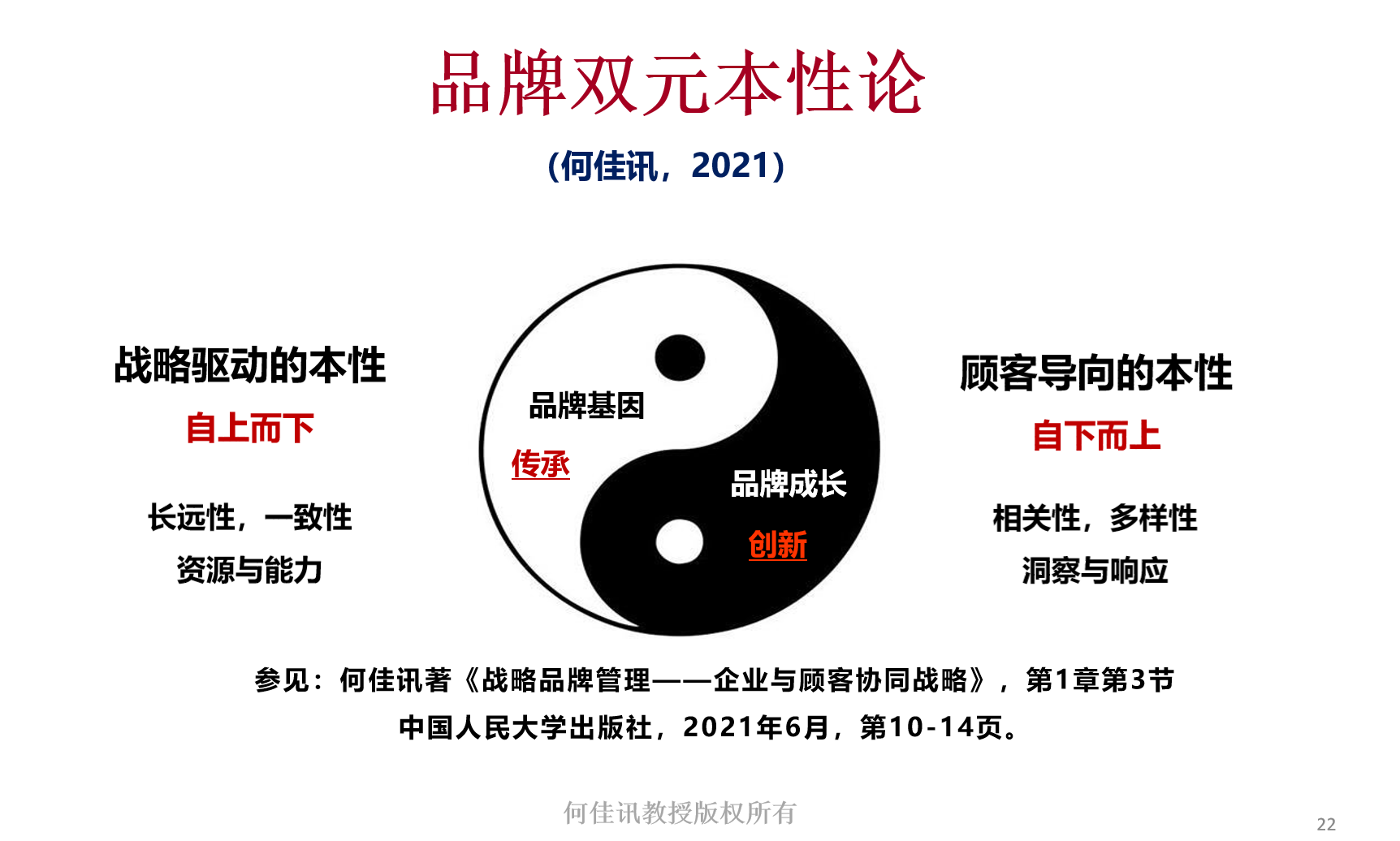
Towards a New Era: The Declining Effectiveness of the Classic Theories of 30 Years Ago
Everyone here must have read a lot of brand professional books, theoretical books, articles on official accounts, etc. In 1988, the American Academy of Marketing Sciences held a special meeting, and the brand theory in the modern sense - brand equity (brand equity) theory officially began to discuss. Today, the effectiveness of these classic theories more than 30 years ago is declining. The theoretical system established by David A. Aaker and Kevin L. Keller in the early 1990s, and the Textbooks and books, started over the past 30 years, have had a huge impact. The knowledge system established with the experience of the Western market has made an indelible contribution to the establishment of disciplines in this field and continues to play a role. But on the whole, the effectiveness of classical theory is declining. At the same time, the theoretical system of brand strategy in emerging markets based on the practice of China's reform and opening up for more than 40 years has become more and more influential.
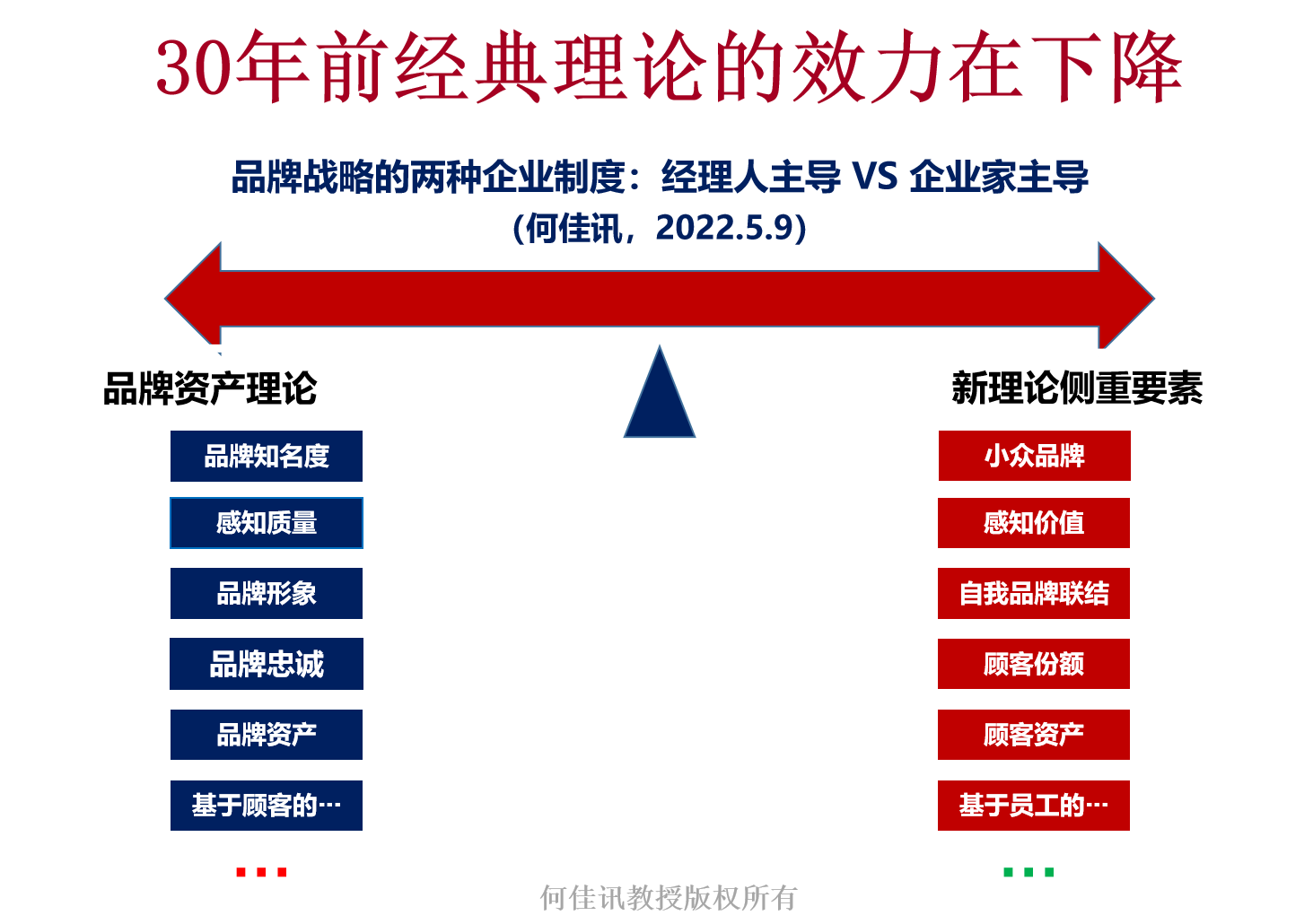
For a simple comparison, the left side is the core elements of the classic brand equity theory, and the right side is some elements that the new theory focuses on when it is established. There are differences between the two. For example, David Acker proposed in his classic textbook that brand equity includes five dimensions, one of which is perceived quality, that is, whether the quality is good or not, which can be perceived with five sensory functions, namely hearing, taste, vision, and touch , smell. For example, the "Long Ago Lamb Skewers" restaurant gave each customer an empty can filled with "Hulunbeier's air", which made customers feel that the ingredients of "Long Ago Lamb Skewers" came from Hulunbeier, Inner Mongolia. This is the use of senses power to generate added value. It is not the quality tested by technology in the laboratory. The higher the perceived quality, the higher the added value of the product.
However, in today's era of hyperlinks, a large number of brands we have established on the Internet rely on reducing costs to establish value and benefits, rather than relying on sensory experience to increase added value. For example, SHEIN, a Chinese brand in the fast fashion field, its core competitiveness is to reduce customers' energy costs, time costs, money costs, transaction costs and other costs to enhance customer value.
Therefore, in the new era of uncertainty, if we still hold Western classic textbooks, we may not be able to find the theoretical guidance and direction that Chinese enterprises really need for the development of today.

